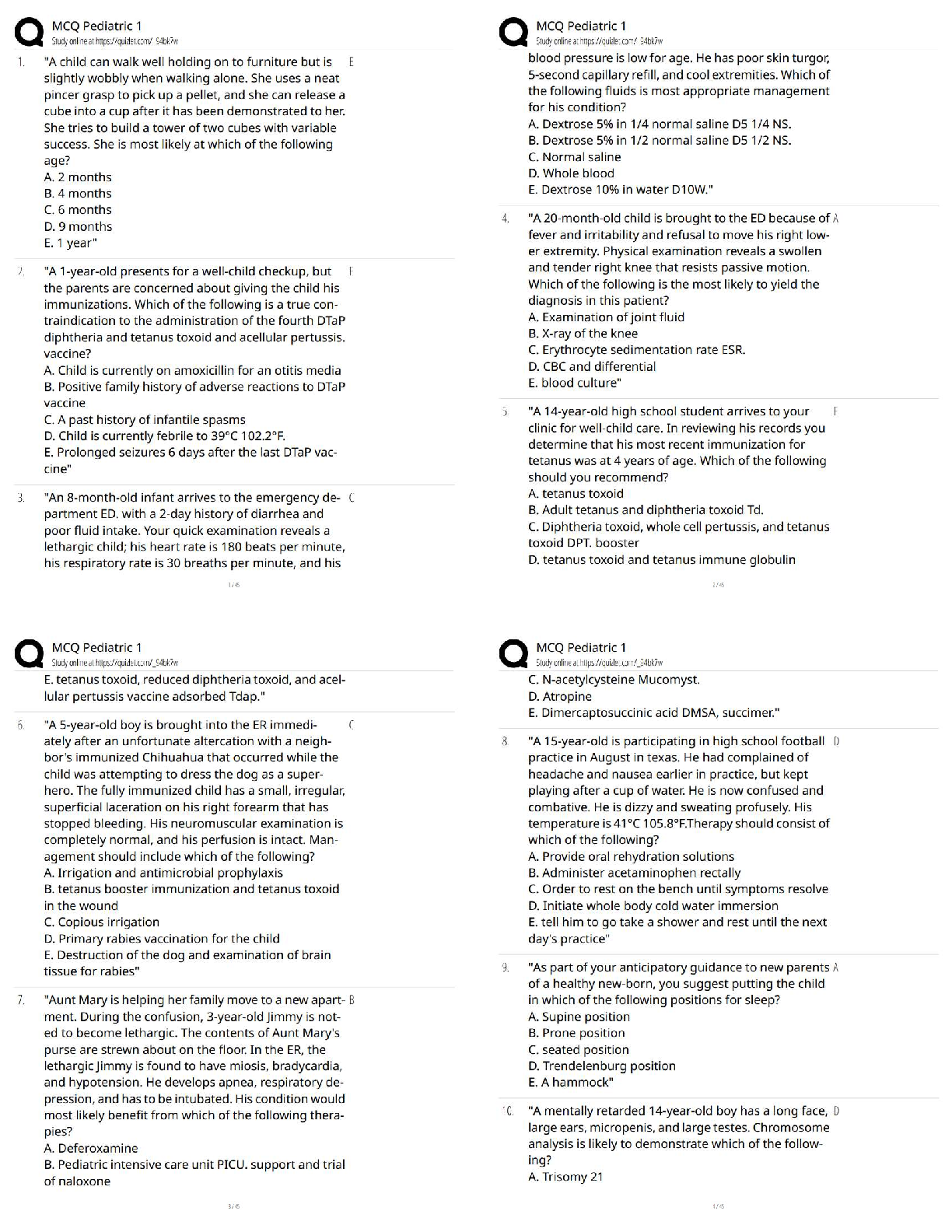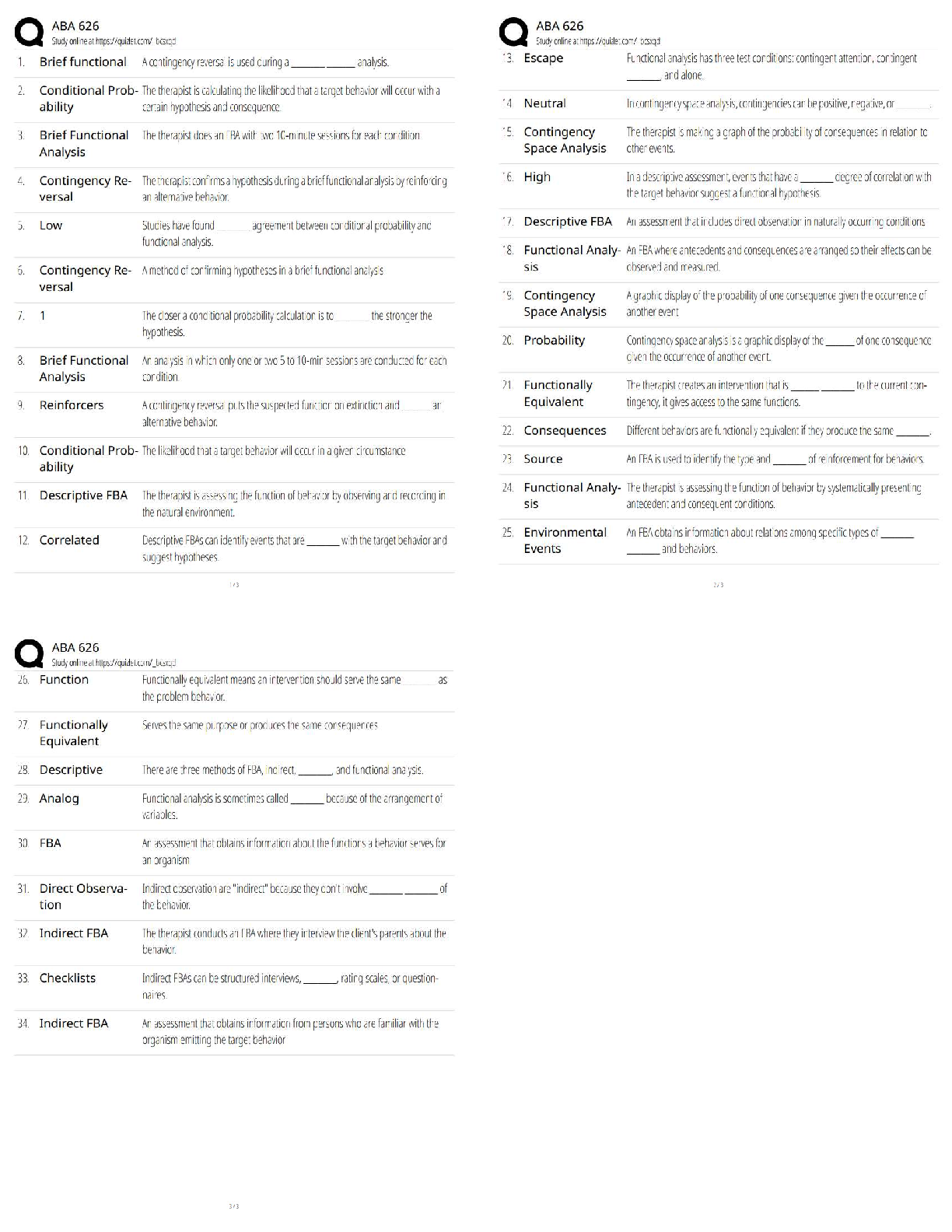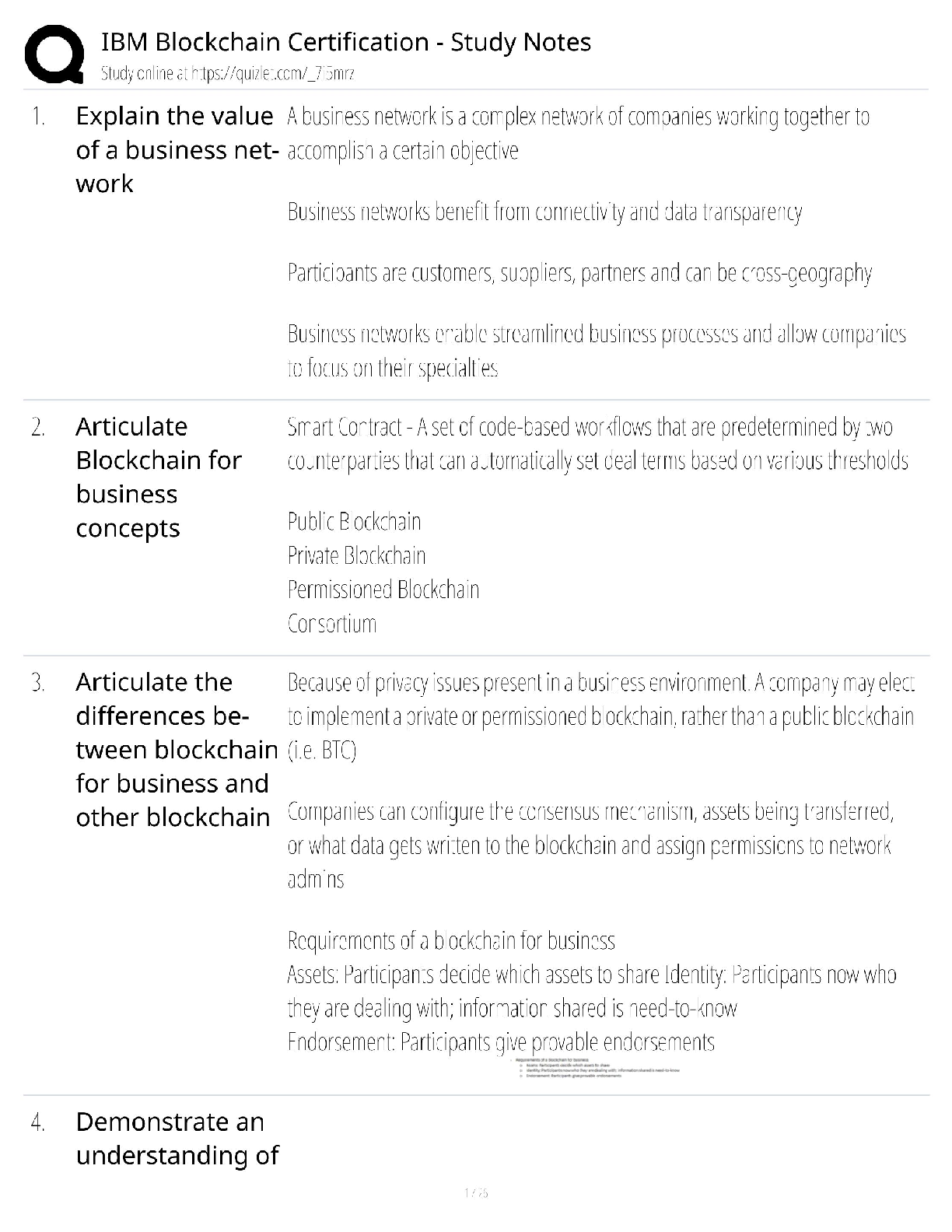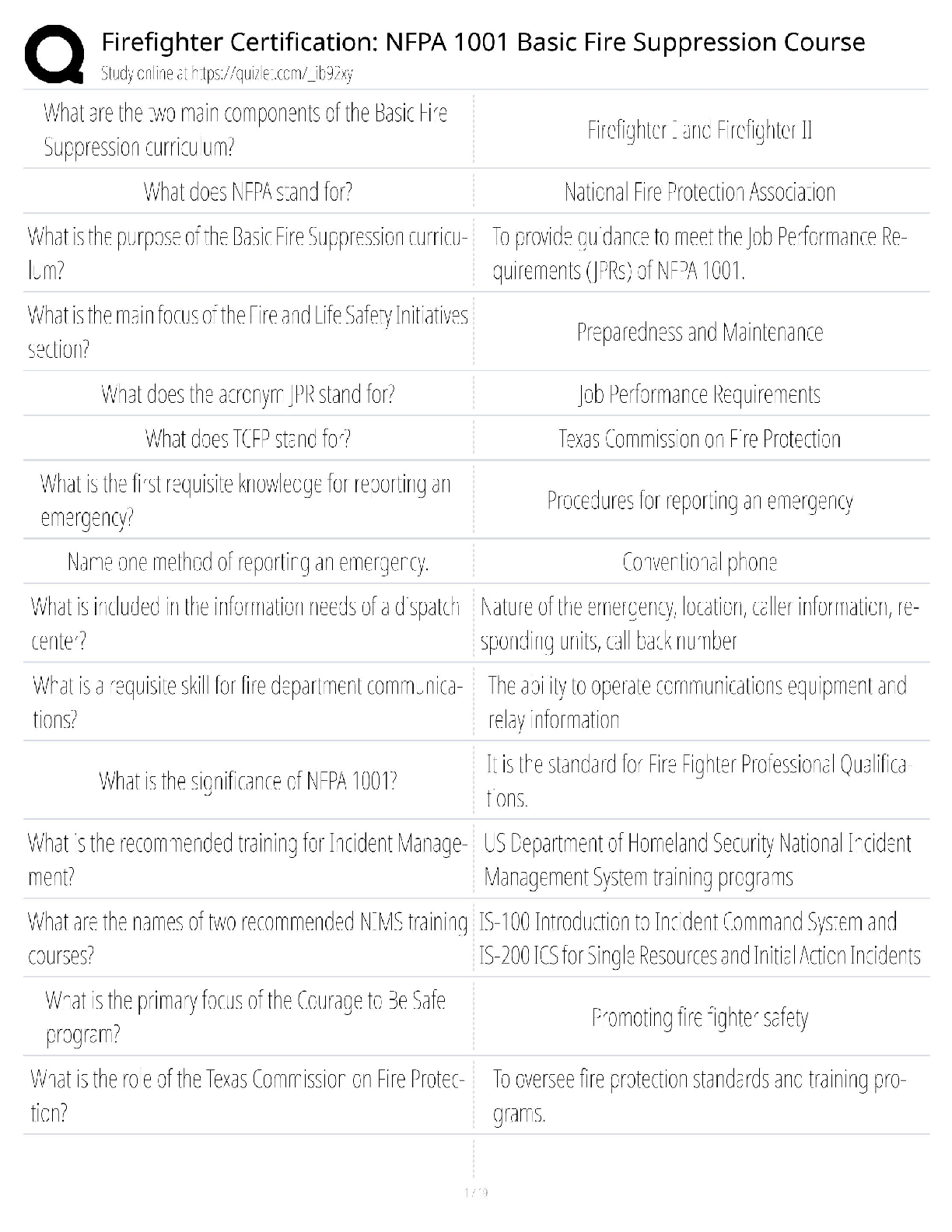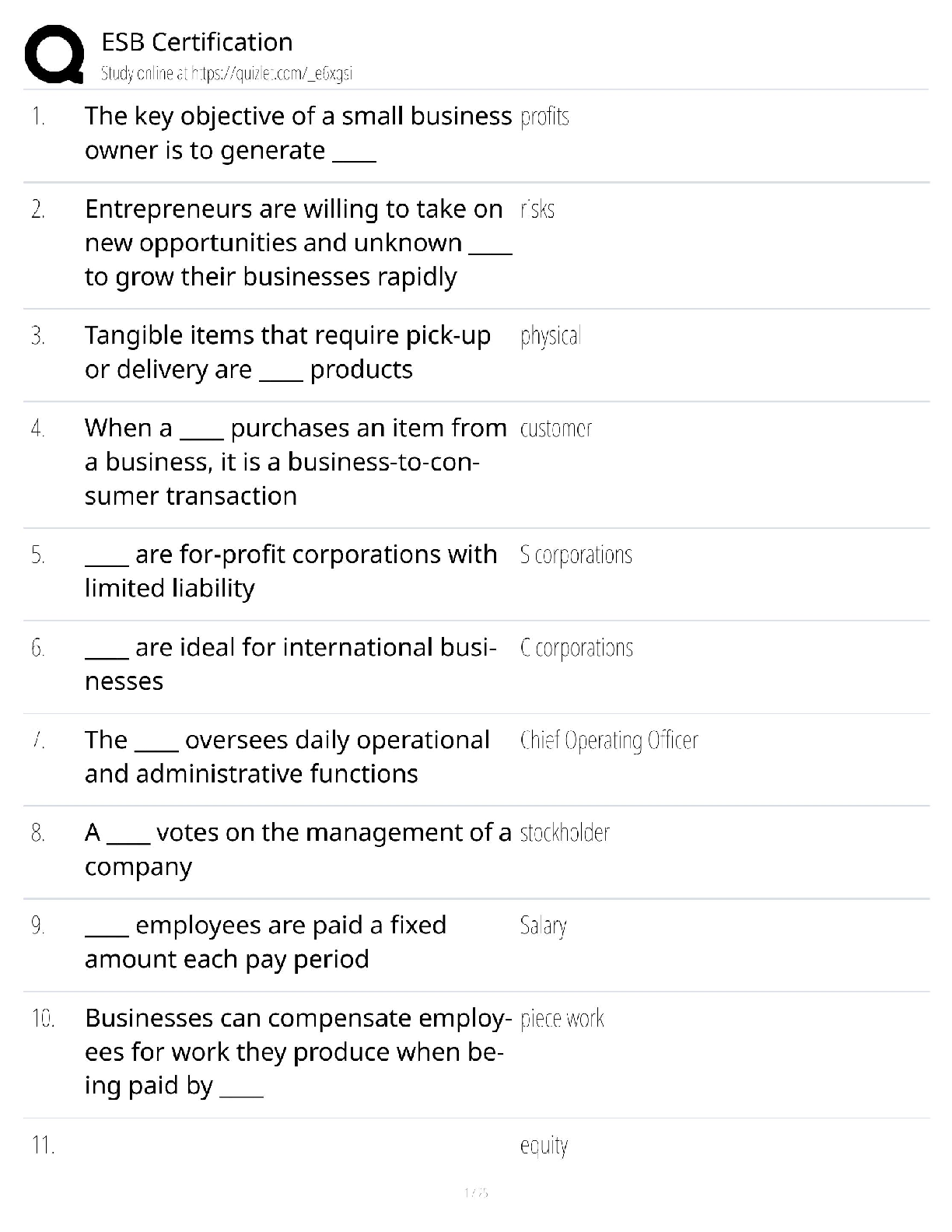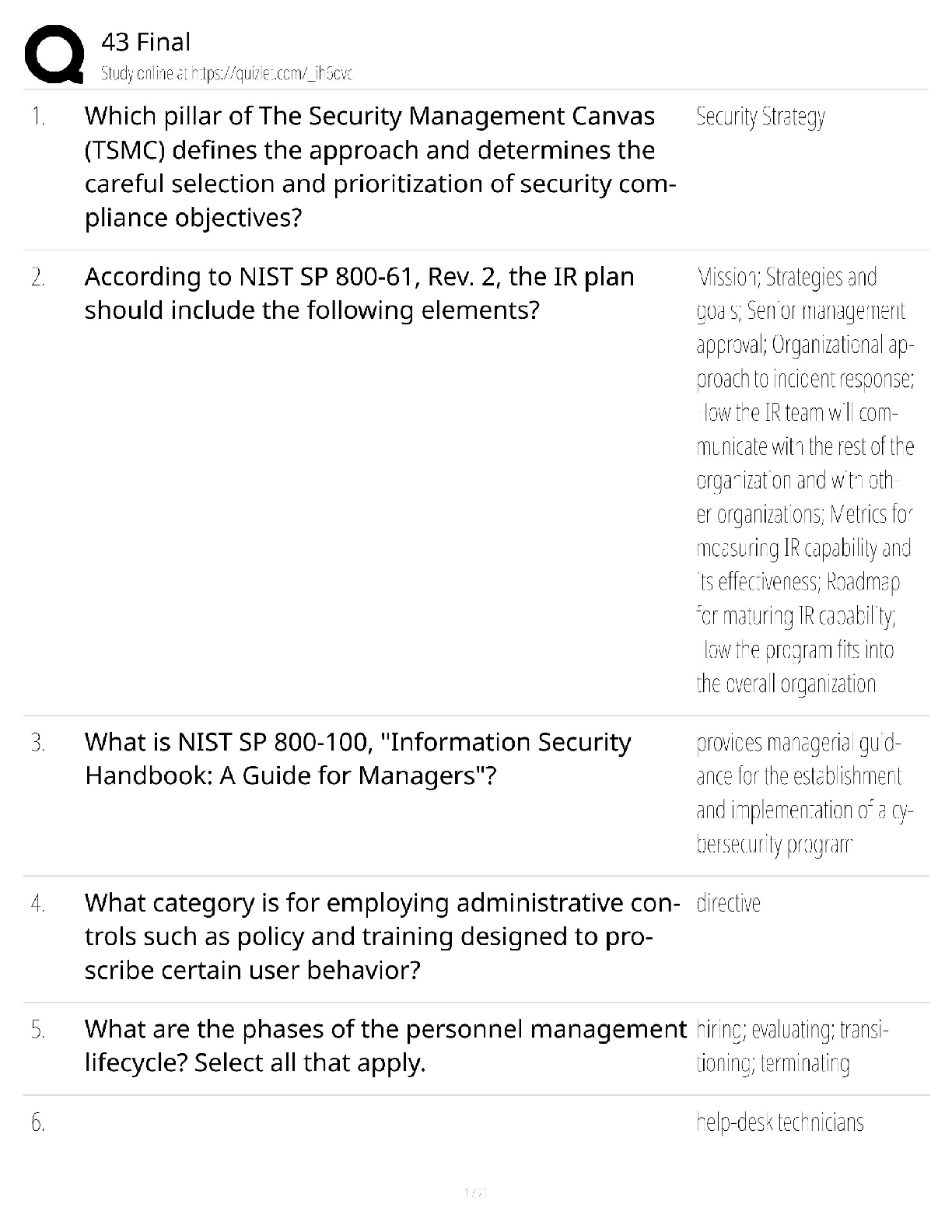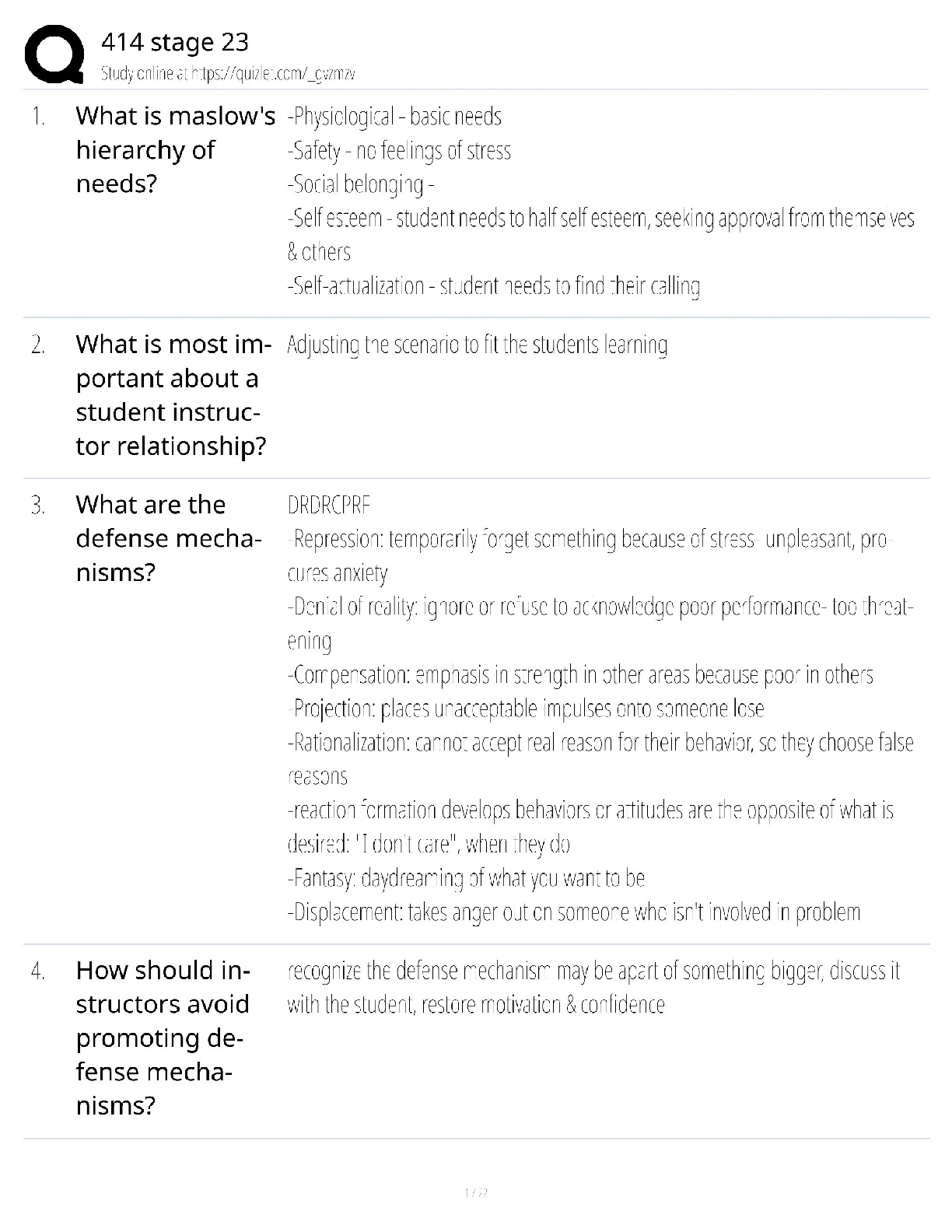CH 14 - Multicriteria Decisions. Questions and Answers
Document Content and Description Below
/
1. Objectives in multicriteria problems seldom conflict.
a.
b.
:
POINTS: 1
DIFFICULTY: Easy
LEARNING OBJECTIVES: IMS.ASWC.19.14.01 - 14.1
NATIONAL STANDARDS: United Sta
...
tes - BUSPROG: Reflective Thinking
TOPICS: 14.1 Goal Programming: Formulation and Graphical Solution
KEYWORDS: Bloom's: Remember
2. Target values will never be met precisely in a goal programming problem.
a.
b.
:
POINTS: 1
DIFFICULTY: Easy
LEARNING OBJECTIVES: IMS.ASWC.19.14.01 - 14.1
NATIONAL STANDARDS: United States - BUSPROG: Reflective Thinking
TOPICS: 14.1 Goal Programming: Formulation and Graphical Solution
KEYWORDS: Bloom's: Understand
3. Goal equations consist of a function that defines goal achievement and deviation variables that measure the distance from the target.
a.
b.
:
POINTS: 1
DIFFICULTY: Easy
LEARNING OBJECTIVES: IMS.ASWC.19.14.01 - 14.1
NATIONAL STANDARDS: United States - BUSPROG: Reflective Thinking
TOPICS: 14.1 Goal Programming: Formulation and Graphical Solution
KEYWORDS: Bloom's: Understand
4. In a goal programming model, there can only be one goal at each priority level.
a.
b.
:
POINTS: 1
DIFFICULTY: Easy
LEARNING OBJECTIVES: IMS.ASWC.19.14.01 - 14.1
NATIONAL STANDARDS: United States - BUSPROG: Reflective Thinking
TOPICS: 14.1 Goal Programming: Formulation and Graphical Solution
KEYWORDS: Bloom's: Understand
5. To solve a goal programming problem with preemptive priorities, successive linear programming programs, with an adjustment to the objective function and an additional constraint, must be solved.
a.
b.
:
POINTS: 1
DIFFICULTY: Easy
LEARNING OBJECTIVES: IMS.ASWC.19.14.01 - 14.1
NATIONAL STANDARDS: United States - BUSPROG: Reflective Thinking
TOPICS: 14.1 Goal Programming: Formulation and Graphical Solution
KEYWORDS: Bloom's: Understand
6. If a problem has multiple goals at different priority levels, then it is rare that all the goals will be achieved with existing resources.
a.
b.
:
POINTS: 1
DIFFICULTY: Easy
LEARNING OBJECTIVES: IMS.ASWC.19.14.02 - 14.2
NATIONAL STANDARDS: United States - BUSPROG: Reflective Thinking
TOPICS: 14.2 Goal Programming: Solving More Complex Problems
KEYWORDS: Bloom's: Understand
7. For a scoring model, the decision maker evaluates each decision alternative by considering the weight or importance of each criterion.
a.
b.
:
POINTS: 1
DIFFICULTY: Easy
LEARNING OBJECTIVES: IMS.ASWC.19.14.03 - 14.3
NATIONAL STANDARDS: United States - BUSPROG: Reflective Thinking
TOPICS: 14.3 Scoring Models
KEYWORDS: Bloom's: Understand
8. In goal programming, deviation variables allow for the possibility of not meeting the target value exactly.
a.
b.
:
POINTS: 1
DIFFICULTY: Easy
LEARNING OBJECTIVES: IMS.ASWC.19.14.01 - 14.1
NATIONAL STANDARDS: United States - BUSPROG: Reflective Thinking
TOPICS: 14.1 Goal Programming: Formulation and Graphical Solution
KEYWORDS: Bloom's: Understand
9. An item's priority reveals how it compares to its competitors on a specific criterion.
a.
b.
:
POINTS: 1
DIFFICULTY: Moderate
LEARNING OBJECTIVES: IMS.ASWC.19.14.06 - 14.6
NATIONAL STANDARDS: United States - BUSPROG: Reflective Thinking
TOPICS: 14.6 Using AHP to Develop an Overall Priority Ranking
KEYWORDS: Bloom's: Understand
10. The priority matrix shows the priority for each item on each criterion.
a.
b.
:
POINTS: 1
DIFFICULTY: Easy
LEARNING OBJECTIVES: IMS.ASWC.19.14.05 - 14.5
NATIONAL STANDARDS: United States - BUSPROG: Reflective Thinking
TOPICS: 14.5 Establishing Priorities Using AHP
KEYWORDS: Bloom's: Understand
11. One limitation of a scoring model is that it uses arbitrary weights that do not necessarily reflect the preferences of the individual decision maker.
a.
b.
:
POINTS: 1
DIFFICULTY: Moderate
LEARNING OBJECTIVES: IMS.ASWC.19.14.03 - 14.3
NATIONAL STANDARDS: United States - BUSPROG: Reflective Thinking
TOPICS: 14.3 Scoring Models
KEYWORDS: Bloom's: Understand
12. A consistency ratio greater than 0.10 indicates inconsistency in the pairwise comparisons.
a.
b.
:
POINTS: 1
DIFFICULTY: Easy
LEARNING OBJECTIVES: IMS.ASWC.19.14.05 - 14.5
NATIONAL STANDARDS: United States - BUSPROG: Reflective Thinking
TOPICS: 14.5 Establishing Priorities Using AHP
KEYWORDS: Bloom's: Understand
13. Requiring a decision maker to provide judgments about the relative importance of each criterion and then specifying a preference for each decision alternative using each criterion is the purpose of the analytic hierarchy process.
a.
b.
:
POINTS: 1
DIFFICULTY: Easy
LEARNING OBJECTIVES: IMS.ASWC.19.14.04 - 14.4
NATIONAL STANDARDS: United States - BUSPROG: Reflective Thinking
TOPICS: 14.4 Analytic Hierarchy Process
KEYWORDS: Bloom's: Understand
14. The goal programming approach can be used when an analyst is confronted with an infeasible solution to an ordinary linear program.
a.
b.
:
POINTS: 1
DIFFICULTY: Easy
LEARNING OBJECTIVES: IMS.ASWC.19.14.02 - 14.2
NATIONAL STANDARDS: United States - BUSPROG: Reflective Thinking
TOPICS: 14.2 Goal Programming: Solving More Complex Problems
KEYWORDS: Bloom's: Understand
15. A problem involving only one priority level is not considered a goal programming problem.
a.
b.
:
POINTS: 1
DIFFICULTY: Easy
LEARNING OBJECTIVES: IMS.ASWC.19.14.02 - 14.2
NATIONAL STANDARDS: United States - BUSPROG: Reflective Thinking
TOPICS: 14.2 Goal Programming: Solving More Complex Problems
KEYWORDS: Bloom's: Understand
16. AHP allows a decision maker to express personal preferences about the various aspects of a multicriteria problem.
a.
b.
:
POINTS: 1
DIFFICULTY: Easy
LEARNING OBJECTIVES: IMS.ASWC.19.14.04 - 14.4
NATIONAL STANDARDS: United States - BUSPROG: Reflective Thinking
TOPICS: 14.4 Analytic Hierarchy Process
KEYWORDS: Bloom's: Understand
17. Goal priorities are referred to as preemptive priorities because the satisfaction of a higher level goal cannot be traded for the satisfaction of a lower level goal.
a.
b.
:
POINTS: 1
DIFFICULTY: Easy
LEARNING OBJECTIVES: IMS.ASWC.19.14.01 - 14.1
NATIONAL STANDARDS: United States - BUSPROG: Reflective Thinking
TOPICS: 14.1 Goal Programming: Formulation and Graphical Solution
KEYWORDS: Bloom's: Remember
Multiple Choice
18. A decision with more than one objective
a. cannot have an optimal solution.
b. requires the decision maker to place the objectives in some order of importance.
c. depends on the probability of satisfying each objective.
d. should be decomposed into a separate model for each objective.
: b
POINTS: 1
DIFFICULTY: Easy
LEARNING OBJECTIVES: IMS.ASWC.19.14.01 - 14.1
NATIONAL STANDARDS: United States - BUSPROG: Reflective Thinking
TOPICS: 14.1 Goal Programming: Formulation and Graphical Solution
KEYWORDS: Bloom's: Understand
19. The objective function in a goal programming model calls for minimizing a function of the
a. goal variables.
b. target variables.
c. deviation variables.
d. preemptive variables.
: c
POINTS: 1
DIFFICULTY: Easy
LEARNING OBJECTIVES: IMS.ASWC.19.14.01 - 14.1
NATIONAL STANDARDS: United States - BUSPROG: Reflective Thinking
TOPICS: 14.1 Goal Programming: Formulation and Graphical Solution
KEYWORDS: Bloom's: Understand
20. Preemptive priorities in goal programming
a. show the target values for the problem.
b. prevent sacrifice of a priority level goal to satisfy a lower level one.
c. force the problem to be a standard linear program.
d. limit deviations to d− only.
: b
POINTS: 1
DIFFICULTY: Easy
LEARNING OBJECTIVES: IMS.ASWC.19.14.01 - 14.1
NATIONAL STANDARDS: United States - BUSPROG: Reflective Thinking
TOPICS: 14.1 Goal Programming: Formulation and Graphical Solution
KEYWORDS: Bloom's: Understand
21. Deviation variables that occur in the objective function
a. indicate the targets.
b. indicate the priorities.
c. allow for the possibility of not meeting the target value exactly.
d. identify the difference between all actual and target values.
: c
POINTS: 1
DIFFICULTY: Moderate
LEARNING OBJECTIVES: IMS.ASWC.19.14.01 - 14.1
NATIONAL STANDARDS: United States - BUSPROG: Reflective Thinking
TOPICS: 14.1 Goal Programming: Formulation and Graphical Solution
KEYWORDS: Bloom's: Understand
22. The variable d− measures the amount
a. over the target and is similar to a slack.
b. less than the target and is similar to a slack.
c. less than the target and is similar to a surplus.
d. under the target and is similar to a surplus.
: b
POINTS: 1
DIFFICULTY: Moderate
LEARNING OBJECTIVES: IMS.ASWC.19.14.01 - 14.1
NATIONAL STANDARDS: United States - BUSPROG: Reflective Thinking
TOPICS: 14.1 Goal Programming: Formulation and Graphical Solution
KEYWORDS: Bloom's: Understand
23. The constraint 5x1 + 3x2 ≤ 150 is modified to become a goal equation, and priority one is to avoid overutilization. Which of the following is appropriate?
a. Min P1d1− ; 5x1 + 3x2 + d1− − d1+ = 150
b. Min P1d1+ ; 5x1 + 3x2 + d1− − d1+ = 150
c. Min P1d1+ ; 5x1 + 3x2 + d1+ = 150
d. Min P1d1+ ; 5x1 + 3x2 − d1+ = 150
: b
POINTS: 1
DIFFICULTY: Challenging
LEARNING OBJECTIVES: IMS.ASWC.19.14.01 - 14.1
NATIONAL STANDARDS: United States - BUSPROG: Analytic
TOPICS: 14.1 Goal Programming: Formulation and Graphical Solution
KEYWORDS: Bloom's: Analyze
24. The goal programming problem with the objective function Min P1(d1+) + P2(d2−) is initially solved by the computer and the objective function value is 0. Which of the following constraints should be added for the second problem?
a. d1+ = 0
b. d1+ + d2− = 0
c. −d1+ + d2− = 0
d. d1+ ≤ 0
: a
POINTS: 1
DIFFICULTY: Challenging
LEARNING OBJECTIVES: IMS.ASWC.19.14.01 - 14.1
NATIONAL STANDARDS: United States - BUSPROG: Analytic
TOPICS: 14.1 Goal Programming: Formulation and Graphical Solution
KEYWORDS: Bloom's: Analyze
25. A required step in the analytic hierarchy process is to determine
a. the goals to be satisfied.
b. the expected value of the criteria.
c. the relative importance of the criteria themselves.
d. how many hierarchies to use.
: c
POINTS: 1
DIFFICULTY: Moderate
LEARNING OBJECTIVES: IMS.ASWC.19.14.04 - 14.4
NATIONAL STANDARDS: United States - BUSPROG: Reflective Thinking
TOPICS: 14.4 Analytic Hierarchy Process
KEYWORDS: Bloom's: Understand
26. Pairwise comparisons are used to
a. compare criteria in terms of the overall goal.
b. compare choices on each criterion.
c. compare criteria in terms of the overall goal and compare choices on each criterion.
d. None of these are correct.
: c
POINTS: 1
DIFFICULTY: Moderate
LEARNING OBJECTIVES: IMS.ASWC.19.14.05 - 14.5
NATIONAL STANDARDS: United States - BUSPROG: Reflective Thinking
TOPICS: 14.5 Establishing Priorities Using AHP
KEYWORDS: Bloom's: Understand
27. The overall priorities for decision alternatives
a. are the sum of the products of the criterion priority times the priority of the decision alternative with respect to that criterion.
b. sum to 1.
c. indicate what choice is preferred, but do not force that choice to be made.
d. All of these are correct.
: d
POINTS: 1
DIFFICULTY: Moderate
LEARNING OBJECTIVES: IMS.ASWC.19.14.06 - 14.6
NATIONAL STANDARDS: United States - BUSPROG: Reflective Thinking
TOPICS: 14.6 Using AHP to Develop an Overall Priority Ranking
KEYWORDS: Bloom's: Understand
28. The steps of the scoring model include all of the following EXCEPT
a. list the decision-making criteria and assign a weight to each.
b. develop a pairwise comparison matrix for each criterion.
c. rate how well each decision alternative satisfies each criterion.
d. compute the total score for each decision alternative.
: b
POINTS: 1
DIFFICULTY: Moderate
LEARNING OBJECTIVES: IMS.ASWC.19.14.03 - 14.3
NATIONAL STANDARDS: United States - BUSPROG: Reflective Thinking
TOPICS: 14.3 Scoring Models
KEYWORDS: Bloom's: Understand
29. Goal programming with preemptive priorities never permits trade-offs between
a. goals with the same priority level and the same weights.
b. goals with different priority levels.
c. goals with the same priority level and different weights.
d. any goals.
: b
POINTS: 1
DIFFICULTY: Moderate
LEARNING OBJECTIVES: IMS.ASWC.19.14.01 - 14.1
NATIONAL STANDARDS: United States - BUSPROG: Reflective Thinking
TOPICS: 14.1 Goal Programming: Formulation and Graphical Solution
KEYWORDS: Bloom's: Understand
30. Inconsistency in pairwise judgments is indicated by a consistency ratio that is
a. less than 0.
b. greater than 0.10.
c. greater than 0.50.
d. greater than 1.00.
: b
POINTS: 1
DIFFICULTY: Easy
LEARNING OBJECTIVES: IMS.ASWC.19.14.05 - 14.5
NATIONAL STANDARDS: United States - BUSPROG: Reflective Thinking
TOPICS: 14.5 Establishing Priorities Using AHP
KEYWORDS: Bloom's: Remember
31. When using a linear programming approach to solving a goal programming problem, a linear program must be solved for each
a. goal.
b. pair of deviation variables.
c. priority level.
d. pairwise comparison.
: c
POINTS: 1
DIFFICULTY: Moderate
LEARNING OBJECTIVES: IMS.ASWC.19.14.01 - 14.1
NATIONAL STANDARDS: United States - BUSPROG: Reflective Thinking
TOPICS: 14.1 Goal Programming: Formulation and Graphical Solution
KEYWORDS: Bloom's: Understand
32. Computing the consistency ratio for a criterion's pairwise comparison matrix is the next step after
a. developing the criterion's pairwise comparison matrix.
b. converting the criterion's pairwise comparison matrix to a normalized matrix.
c. developing the criterion's priority vector.
d. developing the overall priority vector.
: c
POINTS: 1
DIFFICULTY: Moderate
LEARNING OBJECTIVES: IMS.ASWC.19.14.05 - 14.5
NATIONAL STANDARDS: United States - BUSPROG: Reflective Thinking
TOPICS: 14.5 Establishing Priorities Using AHP
KEYWORDS: Bloom's: Understand
Subjective Short
33. Solve the following problem graphically:
Min P1(d1+) + P2(d2−)
s.t. 3x1 + 5x2 ≤ 45
3x1 + 2x2 − d1+ + d1− = 24
x1 + x2 − d2+ + d2− = 10
x1, x2, d1−, d1+, d2−, d2+ ≥ 0
:
POINTS: 1
DIFFICULTY: Challenging
LEARNING OBJECTIVES: IMS.ASWC.19.14.01 - 14.1
NATIONAL STANDARDS: United States - BUSPROG: Analytic
TOPICS: 14.1 Goal Programming: Formulation and Graphical Solution
KEYWORDS: Bloom's: Evaluate
34. Lofton Company has developed the following linear programming problem:
Max x1 + x2
s.t. 2x1 + x2 ≤ 10
2x1 + 3x2 ≤ 24
3x1 + 4x2 ≥ 36
Lofton finds this problem is infeasible. In revision, Lofton drops the original objective and establishes three goals.
Goal 1: Don't exceed 10 in constraint 1.
Goal 2: Don't fall short of 36 in constraint 3.
Goal 3: Don't exceed 24 in constraint 2.
Give the goal programming model and solve it graphically.
35. An ATM is to be located in a campus union building so that it minimizes the distance from the food court, the gift shop, and the theater. They are located at coordinates (2, 2), (0, 6), and (8, 0). Develop a goal programming model to locate the best place for the ATM.
36. As treasurer of the school PTA, you chair the committee that decides how the $20,000 raised by candy sales will be spent. Four kinds of projects have been proposed, and facts on each are shown below.
Project Number
Requested Unit Cost Volunteers Needed
(Person-Days, Each)
Basketball goals 12 $400 2
Encyclopedia sets 5 750 0
Field trips 6 300 3
Computer stations 20 800 0.5
Develop a goal programming model that would represent these goals and priorities.
Priority 1
Goal 1 Spend the entire $20,000.
Goal 2 Do not use more than 50 person-days of volunteer time.
Priority 2
Goal 3 Provide at least as many encyclopedias and computers as requested.
Goal 4 Provide at least as many field trips as requested.
Goal 5 Do not provide any more basketball goals than requested.
37. Rosie's Ribs is in need of an office management software package. After considerable research, Rosie has narrowed her choice to one of three packages: N-able, VersaSuite, and SoftTrack. She has determined her decision-making criteria, assigned a weight to each criterion, and rated how well each alternative satisfies each criterion.
Decision Alternatives
Criterion Weight N-Able VersaSuite SoftTrack
Ease of use 4 3 5 8
Report generation 3 8 7 6
Functional integration 5 5 8 6
Online help 3 8 6 4
Entry error checking 2 8 3 4
Price 4 4 7 5
Support cost 3 6 5 7
Using a scoring model, determine the recommended software package for Rosie's.
: N-Able = 135, VersaSuite = 148, SoftTrack = 141
POINTS: 1
DIFFICULTY: Challenging
LEARNING OBJECTIVES: IMS.ASWC.19.14.03 - 14.3
NATIONAL STANDARDS: United States - BUSPROG: Analytic
TOPICS: 14.3 Scoring Models
KEYWORDS: Bloom's: Evaluate
38. A consumer group is using AHP to compare four used car models. Part of the pairwise comparison matrix for "repair frequency" is shown below.
a. Complete the matrix.
b. Does it seem to be consistent?
Repair Frequency Model A Model B Model C Model D
Model A 1 5 1/6
Model B 1/5 1 1/2
Model C 1/4 1/3 1
Model D 1/4 1
39. A computer company looking for a new location for a plant has determined three criteria to use to rate cities. Pairwise comparisons are given.
Recreation
Opportunities Proximity to
University Cost of
Living
Recreation opportunities 1 1/3 1/5
Proximity to university 3 1 1/4
Cost of living 5 4 1
Determine priorities for the three relative to the overall location goal.
40. In an AHP problem, the priorities for three criteria are as follows:
Criterion 1 0.1722
Criterion 2 0.1901
Criterion 3 0.6377
The priority matrix is as follows
Criterion 1 Criterion 2 Criterion 3
Choice 1 0.425 0.292 0.850
Choice 2 0.330 0.251 0.105
Choice 3 0.245 0.457 0.045
Compute the overall priority for each choice.
41. Like many high school seniors, Anne has several universities to consider when making her final college choice. To assist in her decision, she has decided to use AHP to develop a ranking for school R, school P, and school M. The schools will be evaluated on five criteria, and Anne's pairwise comparison matrix for the criteria is shown below.
Distance Program Size Campus Climate Cost
Distance 1 1/4 2 3 4
Program 4 1 4 5 6
Size 1/2 1/4 1 3 3
Climate 1/3 1/5 1/3 1 2
Cost 1/4 1/6 1/3 1/2 1
The universities' pairwise comparisons on the criteria are shown below.
Distance R P M
R 1 2 3
P 1/2 1 3/2
M 1/3 2/3 1
Programs R P M
R 1 1/2 1
P 2 1 2
M 1 1/2 1
Size R P M
R 1 4 2
P 1/4 1 1/2
M 1/2 2 1
Climate R P M
R 1 1 3
P 1 1 3
M 1/3 1/3 1
Cost R P M
R 1 1/5 1
P 5 1 5
M 1 1/5 1
a. What is the overall ranking of the five criteria?
b. What is the overall ranking of the three universities?
42. John Harris is interested in purchasing a new Harley-Davidson motorcycle. He has narrowed his choice to one of three models: Sportster Classic, Heritage Softtail, and Electra Glide. After much consideration, John has determined his decision-making criteria, assigned a weight to each criterion, and rated how well each decision alternative satisfies each criterion.
Decision Alternative
Criterion
Weight Sportster Classic Heritage
Softtail Electra Glide
Wind protection 5 3 6 8
Fuel tank capacity 3 5 7 6
Passenger comfort 2 5 6 8
Seat height 3 8 5 6
Acceleration 4 8 5 3
Vehicle weight 3 8 6 3
Storage capacity 3 4 5 8
Using a scoring model, determine the recommended motorcycle model for John.
43. The campaign headquarters of Jerry Black, a candidate for the board of supervisors, has 100 volunteers. With one week to go in the election, three major strategies are remaining: media advertising, door-to-door canvassing, and telephone campaigning. Each phone call is estimated to take approximately four minutes and each door-to-door personal contact will average seven minutes. These times include time between contacts for breaks, transportation, dialing, etc. Volunteers who work on advertising will not be able to handle any other duties. Each ad will utilize the talents of three workers for the entire week.
Volunteers are expected to work 12 hours per day during the final seven days of the campaign. At a minimum, Jerry Black feels he needs 30,000 phone contacts, 20,000 personal contacts, and three advertisements during the last week. However, he would like to see 50,000 phone contacts and 50,000 personal contacts made and five advertisements developed. Advertising is believed to be 50 times as important as personal contacts, which in turn are twice as important as phone contacts.
Formulate this goal programming problem with a single weighted priority to determine how the work should be distributed during the final week of the campaign.
[Show More]
Last updated: 3 years ago
Preview 1 out of 18 pages









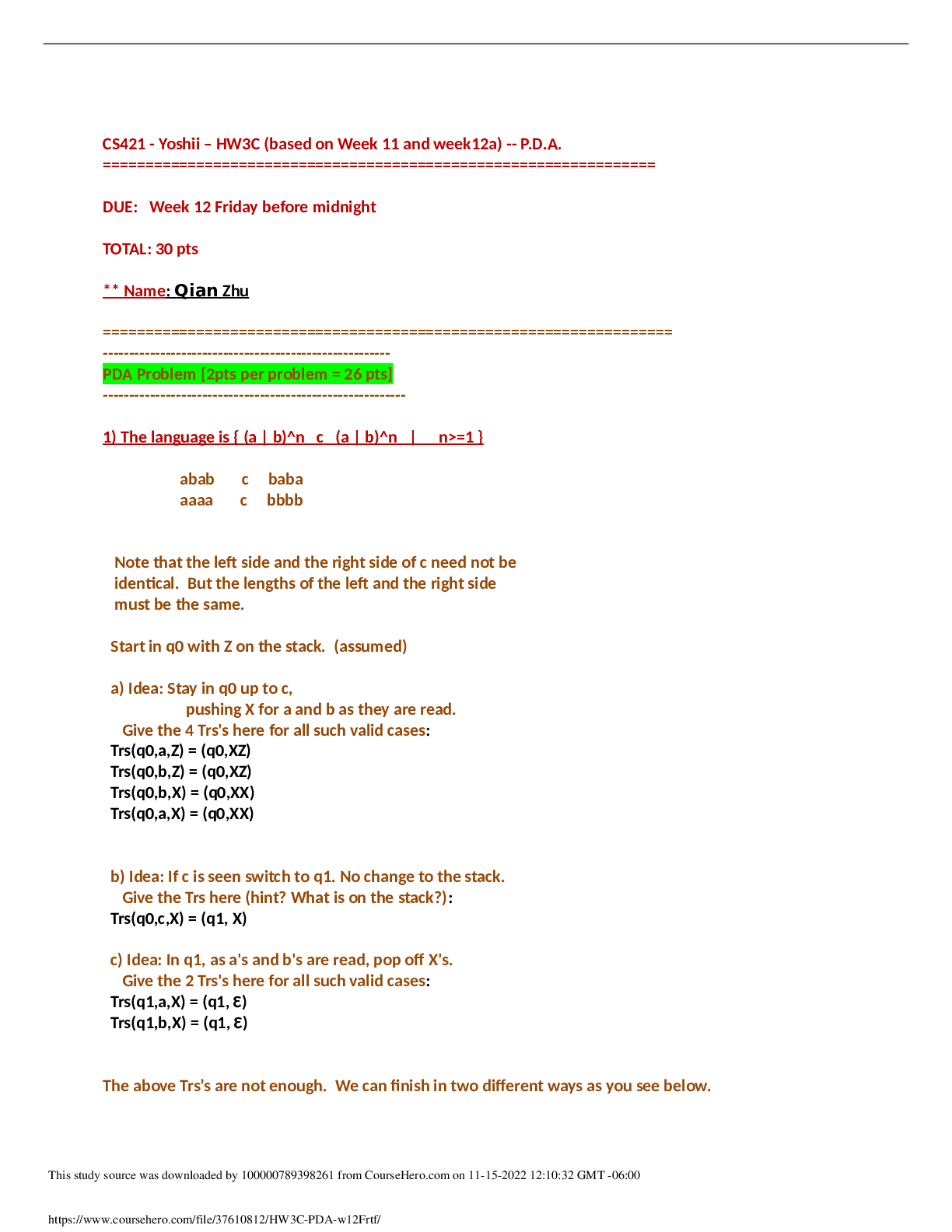


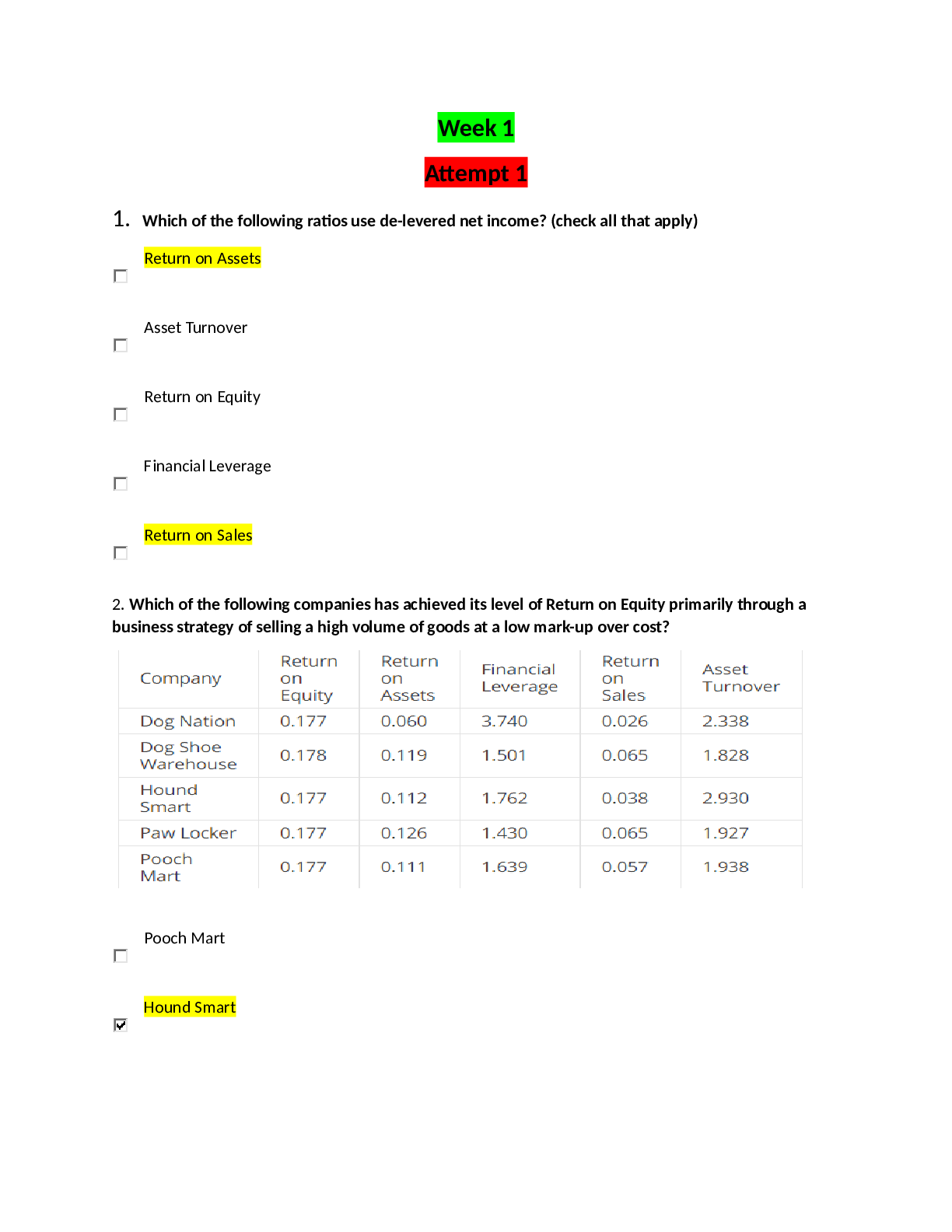
.png)
.png)
.png)
.png)
.png)
